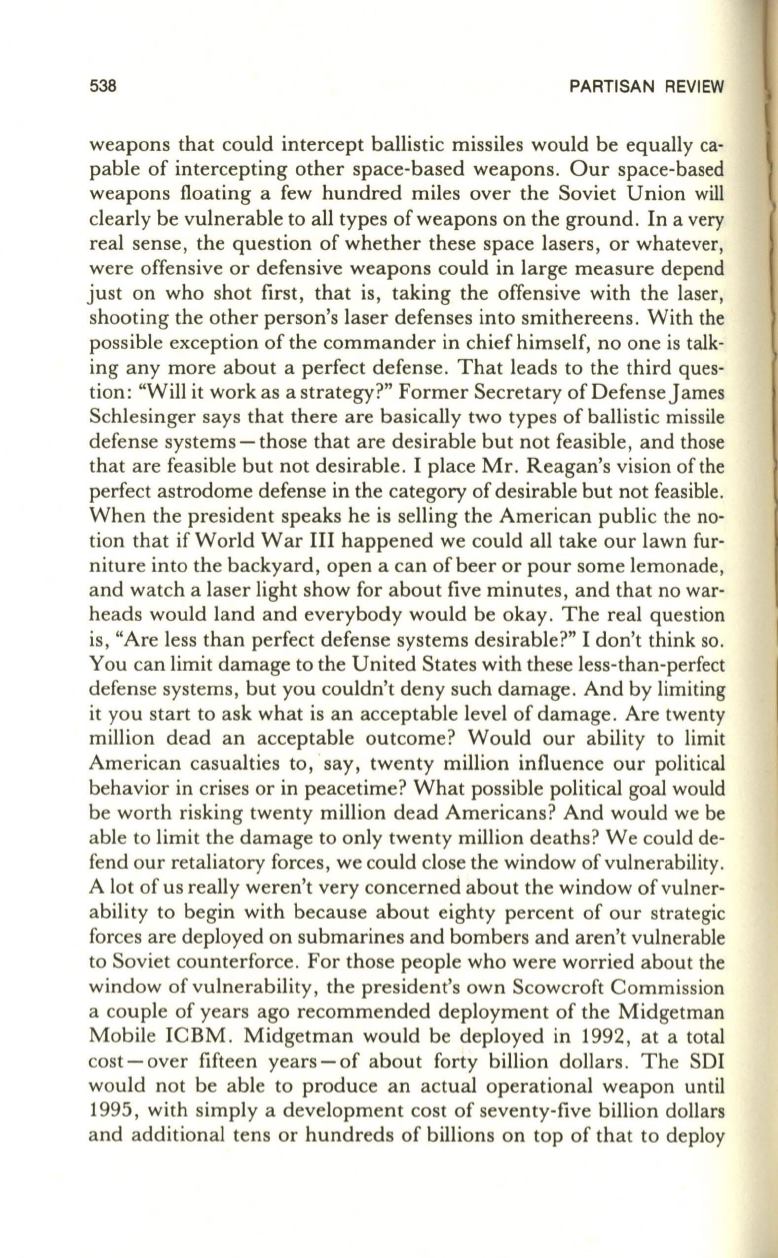
538
PARTISAN REVIEW
weapons that could intercept ballistic missiles would be equally ca–
pable of intercepting other space-based weapons . Our space-based
weapons floating a few hundred miles over the Soviet Union will
clearly be vulnerable to all types of weapons on the ground. In a very
real sense, the question of whether these space lasers, or whatever,
were offensive or defensive weapons could in large measure depend
just on who shot first, that is, taking the offensive with the laser,
shooting the other person's laser defenses into smithereens . With the
possible exception of the commander in chief himself, no one is talk–
ing any more about a perfect defense . That leads to the third ques–
tion: "Will it work as a strategy?" Former Secretary of Defense James
Schlesinger says that there are basically two types of ballistic missile
defense systems - those that are desirable but not feasible, and those
that are feasible but not desirable . I place Mr. Reagan's vision of the
perfect astrodome defense in the category of desirable but not feasible .
When the president speaks he is selling the American public the no–
tion that if World War III happened we could all take our lawn fur–
niture into the backyard, open a can of beer or pour some lemonade,
and watch a laser light show for about five minutes, and that no war–
heads would land and everybody would be okay . The real question
is , "Are less than perfect defense systems desirable?" I don't think so .
You can limit damage to the United States with these less-than-perfect
defense systems, but you couldn't deny such damage. And by limiting
it you start to ask what is an acceptable level of damage. Are twenty
million dead an acceptable outcome? Would our ability to limit
American casualties to, ·say, twenty million influence our political
behavior in crises or in peacetime? What possible political goal would
be worth risking twenty million dead Americans? And would we be
able to limit the damage to only twenty million deaths? We could de–
fend our retaliatory forces, we could close the window of vulnerability.
A lot of us really weren't very concerned about the window of vulner–
ability to begin with because about eighty percent of our strategic
forces are deployed on submarines and bombers and aren't vulnerable
to Soviet counterforce . For those people who were worried about the
window of vulnerability , the president's own Scowcroft Commission
a couple of years ago recommended deployment of the Midgetman
Mobile ICBM. Midgetman would be deployed in 1992, at a total
cost - over fifteen years - of about forty billion dollars. The SDI
would not be able to produce an actual operational weapon until
1995 , with simply a development cost of seventy-five billion dollars
and additional tens or hundreds of billions on top of that to deploy


